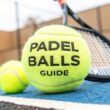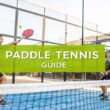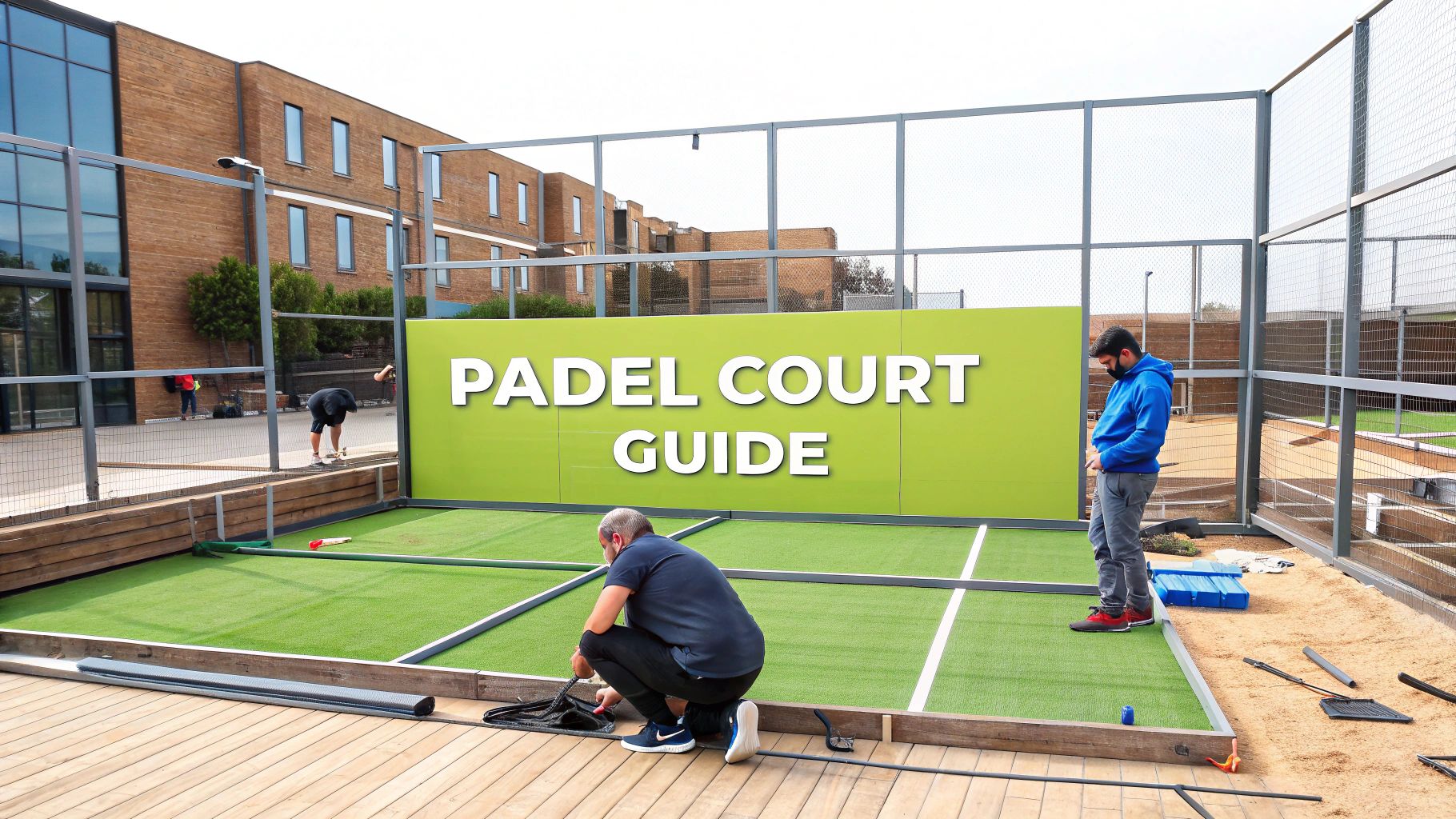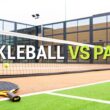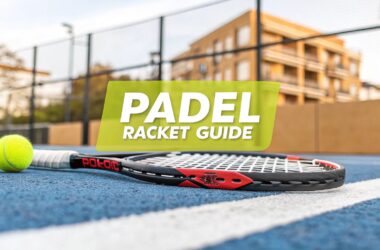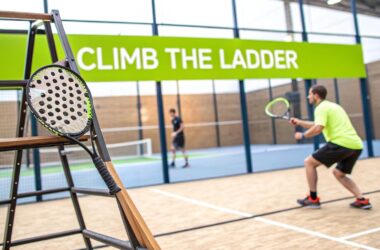Padel courts are so much more than just a place to play; they're the heart of one of the fastest-growing sports crazes on the planet. Their signature glass-and-mesh enclosure isn't just for show—it creates a uniquely dynamic and social game, which is fueling an explosion in popularity from its European heartland all the way to the United States.
The Global Padel Court Phenomenon
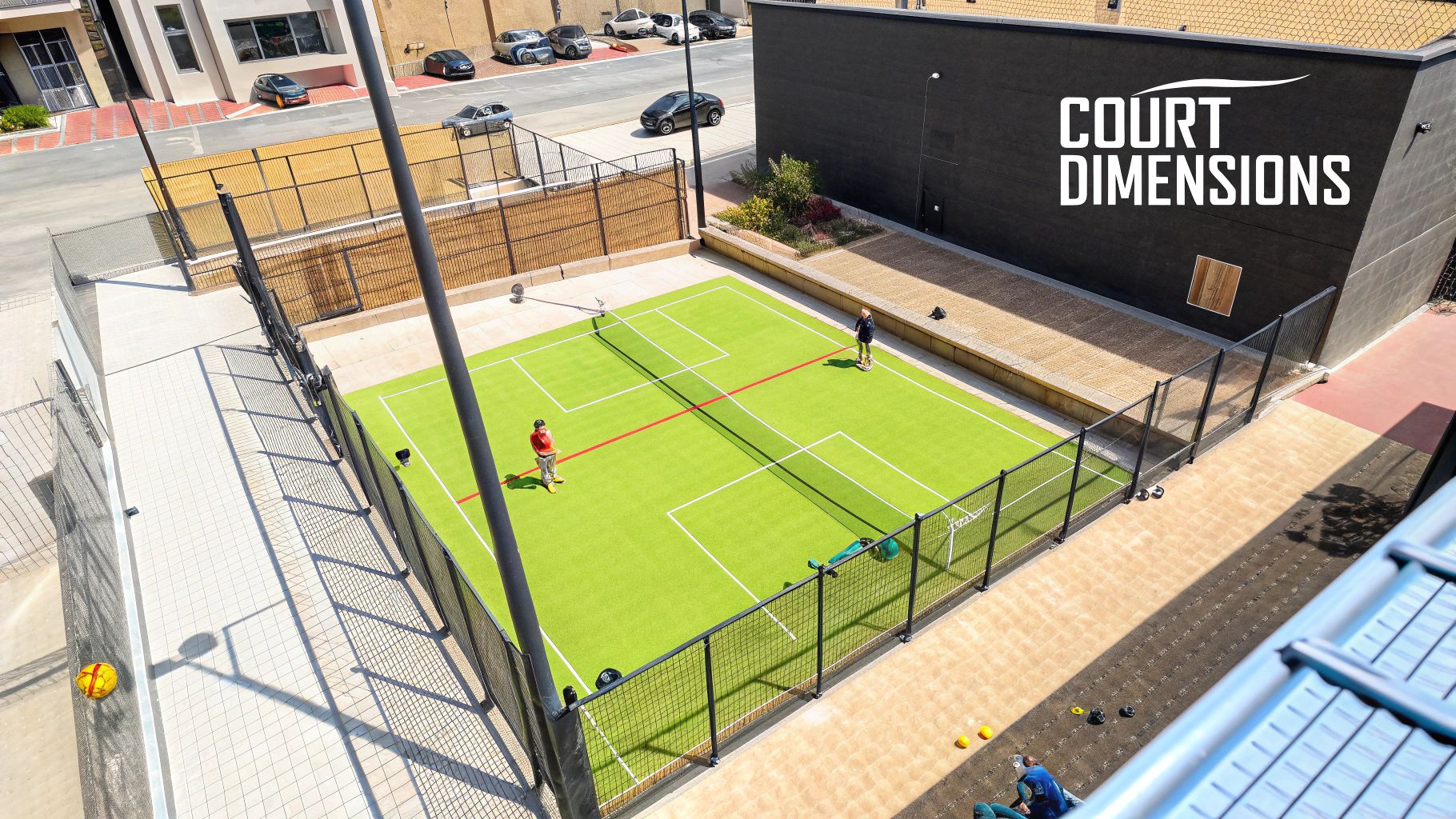
What started as a niche sport has absolutely rocketed into an international sensation. Padel's rise isn't just some passing fad. It's a full-blown global movement, backed by a seriously passionate community and major investment. As a hybrid of tennis and squash, it's incredibly welcoming, making it easy for total beginners to grab a racket and get in the game almost instantly.
The growth numbers are just staggering. In 2024 alone, the number of padel courts worldwide shot up by 26%. That's an addition of 7,187 new courts, bringing the global count to over 50,000. This boom supported 15,933 clubs, with nearly nine new clubs opening their doors every single day. Looking ahead, projections show the court total soaring past 81,000 by 2027, proving a massive, sustained demand. You can dig deeper into these figures in a recent executive study.
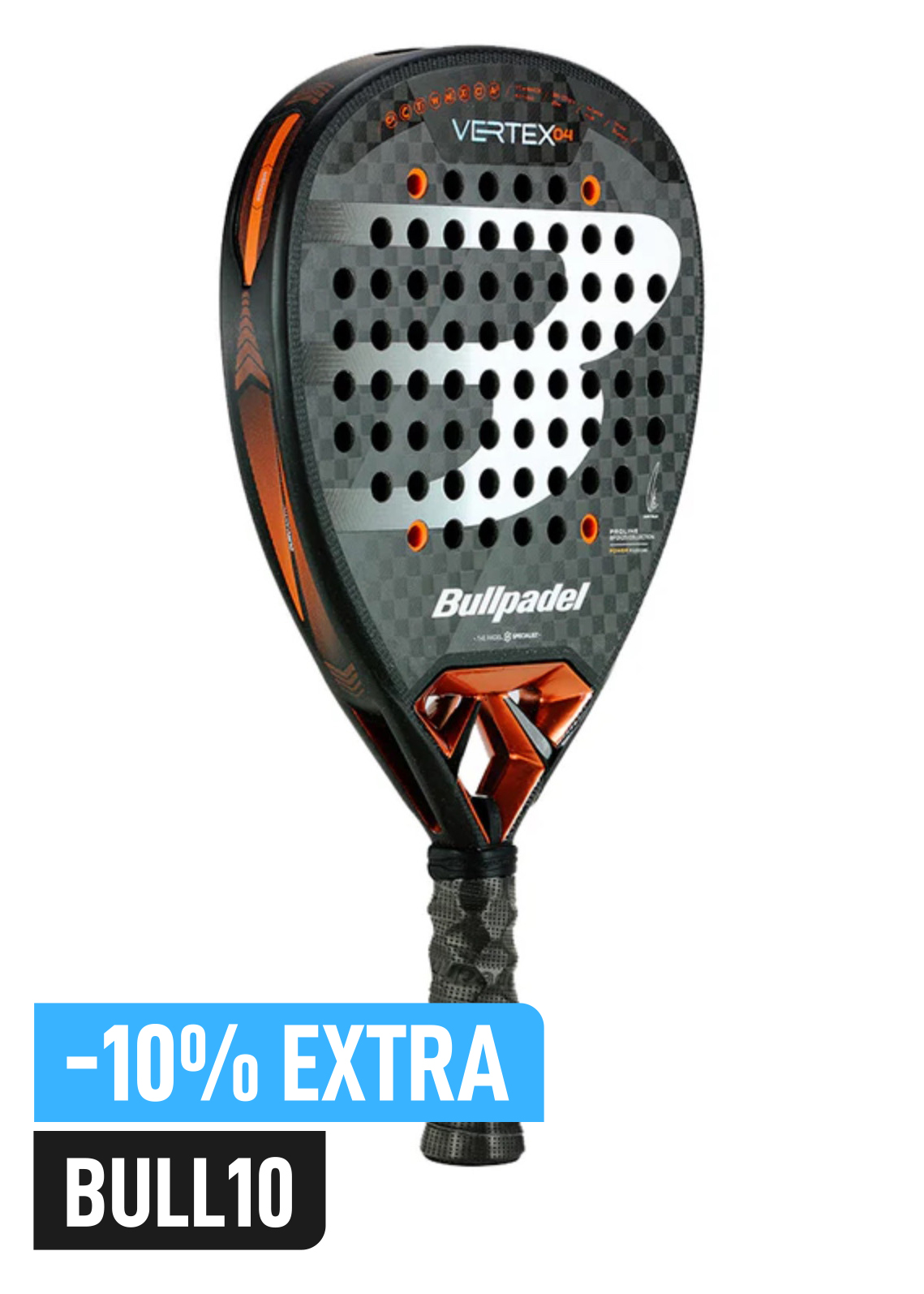
Buy the best padel gear to level up your next game!
CHECK OUT this deal from Padel Market!Get ready to take your game to the next level with the latest padel gear from Padel Market! Fast EU and Worldwide Shipping
This isn't just about building courts; it's about building communities. Each new court becomes a hub for social interaction, fitness, and competition, attracting a diverse mix of players of all ages and skill levels.
Why This Guide Matters Now
With this explosive growth, understanding the ins and outs of padel courts is more critical than ever before. It doesn't matter if you're a club owner planning an expansion, a real estate developer eyeing a new amenity, or just an enthusiast dreaming of a court at home—the choices you make will have lasting consequences. Think of this guide as your go-to resource, cutting through the hype to give you practical, actionable advice.
We’ve put together a clear roadmap to help you master the essentials and invest wisely. Here’s a peek at what we'll cover:
- Court Anatomy: We'll break down every piece of the puzzle, from the playing surface to those iconic glass walls.
- Court Types: Permanent vs. portable, indoor vs. outdoor—we’ll compare the options so you can find the perfect fit.
- Construction Process: A step-by-step walkthrough, taking you from site prep all the way to the final installation.
- Investment Costs: A transparent look at what you can expect to budget, from a basic setup to a pro-level court.
- Essential Maintenance: Practical tips to protect your investment and keep your court in top shape for years to come.
Understanding the Anatomy of a Padel Court
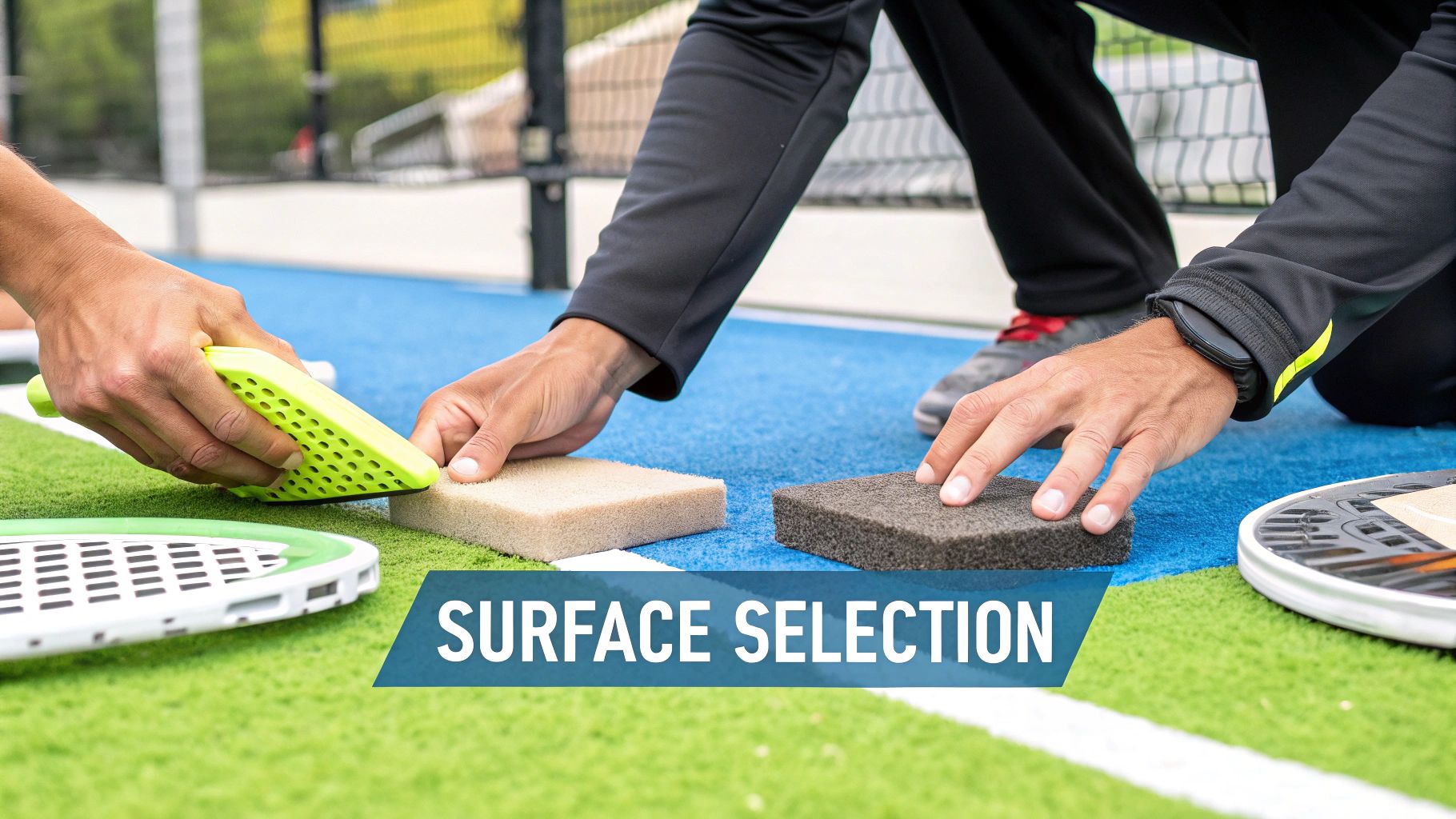
Ever wondered what makes a padel court tick? Think of it less like a tennis court and more like a "glass box arena" where every single element is built for action. The walls aren't just boundaries; they're an active part of the game. Getting to know the 'why' behind its design is the first step to truly appreciating what makes padel so addictive.
The heart of the court is a rectangle measuring 20 meters long by 10 meters wide. A net slices this space in half, creating two equal sides. This setup is much more compact than a tennis court, which naturally leads to faster rallies, quicker reflexes, and a huge emphasis on teamwork. It’s a big reason why the sport feels so social and intense right from the start.
This smaller, enclosed space completely changes the game from one of pure power to one of strategic chess. Players learn to rely on clever angles, rebound shots, and soft touches to outmaneuver their opponents. For a deeper dive into how court design is evolving, Padel Rumors consistently covers the latest official padel court news.
The Walls: Glass and Mesh Enclosure
The most striking feature of any padel court is its enclosure, which is a smart combination of glass panels and metal mesh. This isn't just about keeping the ball from flying away—it’s the core of the sport’s strategy.
The back walls and the corners of the side walls are made from tempered glass, usually 10 to 12 millimeters thick. This isn't just for looks. The glass is chosen for its incredible strength and, more importantly, for providing a true and predictable rebound. A perfectly hit ball off the back glass can instantly flip a defensive scramble into a powerful attack.
The rest of the court is fenced in with a tough steel or wire mesh. Unlike the glass, the bounce off the mesh is unpredictable and much deader. This adds a whole other layer of complexity. Good players have to anticipate whether the ball will hit the glass or the mesh and adjust their position and shot in a split second.
A padel court isn’t just a playing surface; it’s a three-dimensional game board. Mastering the use of the walls is as crucial as mastering your forehand or backhand.
The Playing Surface and Net
What’s under your feet has a huge say in the game's speed and feel. Most courts use artificial turf that's lightly dusted with a fine layer of silica sand. This sand is key: it gives players the grip they need, allows for just enough slide into a shot, and helps control the speed of the ball's bounce.
The net also plays its part. It stands 88 centimeters high at the center and rises to 92 centimeters at the posts. Being lower than a tennis net, it practically invites players to the net for aggressive volleys and fast-paced exchanges, which is what makes padel so thrilling to watch and play.
Standard Padel Court Specifications at a Glance
To bring it all together, here’s a quick breakdown of how each component of a regulation court is designed to shape the game.
| Component | Specification | Purpose in Gameplay |
|---|---|---|
| Playing Area | 20m x 10m | Creates a compact, fast-paced game that prioritizes strategy over power. |
| Glass Walls | 10-12mm Tempered Glass | Provides a true, predictable rebound for strategic, off-the-wall shots. |
| Mesh Walls | Steel Wire Mesh | Offers an irregular, deadened bounce, adding an element of unpredictability. |
| Net Height | 88cm (center) | Encourages aggressive net play, volleys, and quick attacking exchanges. |
| Surface | Artificial Turf with Sand | Ensures consistent ball bounce, player safety, and controlled sliding. |
As you can see, every piece of the puzzle, from the ground up, is engineered to create the fast, strategic, and incredibly social game that has taken the world by storm.
Choosing the Right Padel Court Type and Surface
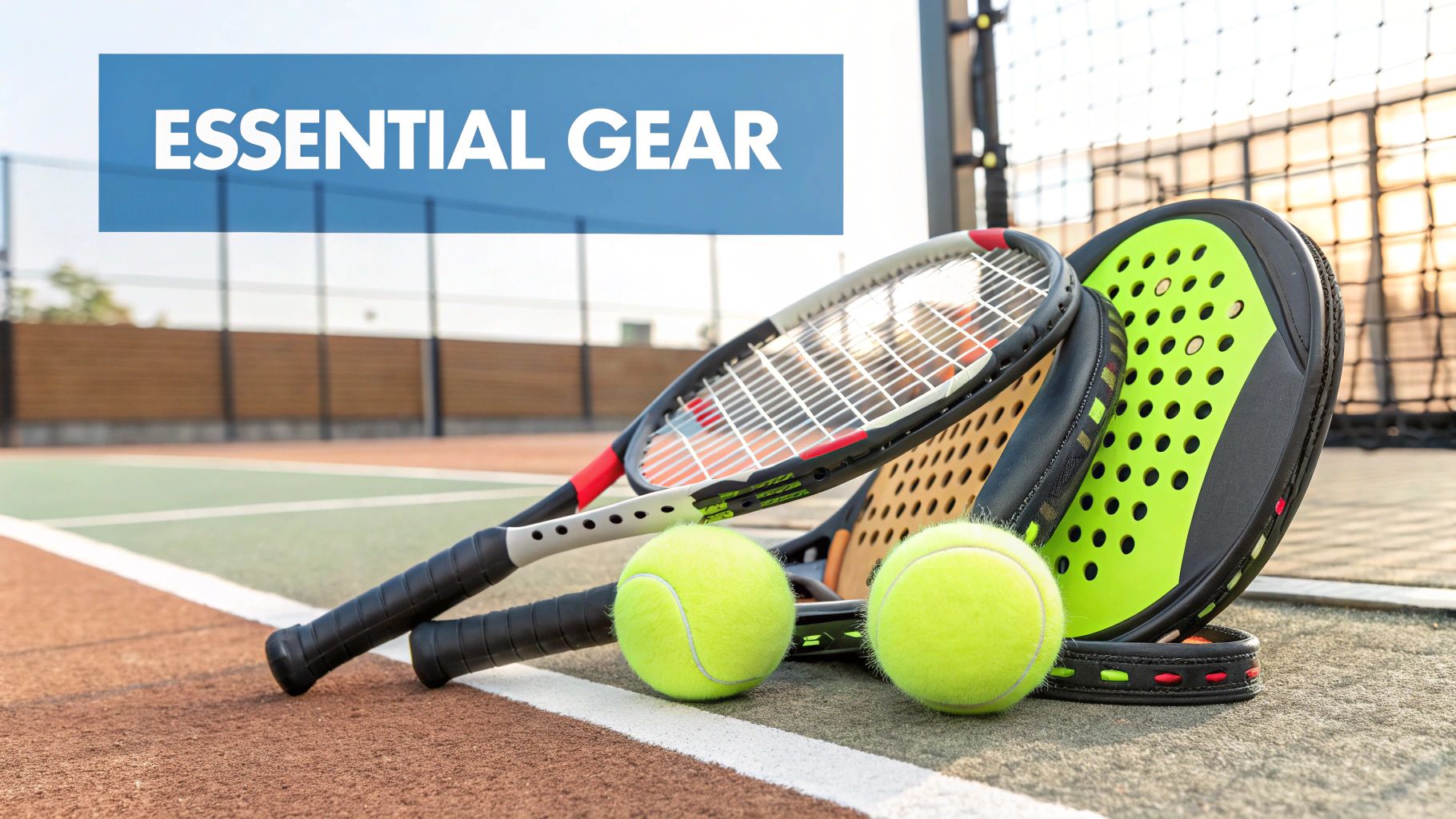

Buy the best padel gear to level up your next game!
CHECK OUT this deal from Padel Market!Get ready to take your game to the next level with the latest padel gear from Padel Market! Fast EU and Worldwide Shipping
So, you're ready to build a padel court. Awesome. But let’s get one thing straight: not all courts are created equal. The choices you make right now will dictate everything from your upfront costs to what it actually feels like to play on it every day. Think of it like picking an engine for a car—this decision defines the court's performance, how much upkeep it needs, and whether you'll love it for years to come.
This is a bigger deal than ever, with padel exploding across the globe. As of early 2025, the sport is played on roughly 70,000 courts in 150 countries. Europe is the heartland, home to about 60% of the world's estimated 30 million players. And with women making up nearly 40% of that number, it's clear you need courts that cater to a wide range of players. You can dig deeper into these numbers with these global padel statistics.
Whether you're a club owner trying to get the best return on your investment or a homeowner building a backyard court, getting a handle on your options is the first step to making a smart choice.
Permanent vs Portable Padel Courts
One of the first big forks in the road is deciding between a permanent or a portable court. Permanent courts are the standard you see everywhere, but portable models have a unique flexibility that can be a game-changer for certain situations.
A permanent court is the real deal—anchored into a concrete foundation for maximum sturdiness and a long lifespan. This is the go-to for padel clubs, resorts, and private homes where the court is meant to stay put.
A portable court, on the other hand, is built to be taken apart, moved, and set up again. Its structure is self-supporting, so it doesn't need to be bolted into the ground. This makes it perfect for special events, tournaments in cool locations, or clubs that only operate seasonally.
Indoor vs Outdoor Installations
Next up: do you put a roof over it or not? This choice usually boils down to two things: your local weather and your business plan.
Outdoor Padel Courts
- Pros: They're cheaper to build upfront because you don't need a whole building. You also get that classic, playing-in-the-sunshine vibe that can be a huge draw.
- Cons: You're at the mercy of the weather. Rain, wind, or crazy heat means canceled games and lost revenue. You'll also absolutely need to install lighting for any evening play.
Indoor Padel Courts
- Pros: Play is guaranteed, 365 days a year, no matter what's happening outside. This means a steady stream of bookings and income. Plus, the court itself is protected from the elements, which can help it last longer.
- Cons: The initial cost is much, much higher. You're not just building a court; you're building a whole structure around it, complete with proper ventilation and high ceilings.
Key Insight: For club owners in places with harsh winters or scorching summers, going indoors often pays for itself faster. Why? Because you can book those courts 100% of the time, guaranteeing revenue.
Decoding the Playing Surface
The court surface is where the magic happens. It's what dictates how the ball bounces, how fast the game is, and how your knees feel the next day. While a few options exist, one has become the undisputed king of modern padel courts: artificial turf.
Artificial Grass: The Industry Standard
Artificial grass just nails the balance between grip for your feet, a nice slide for those tough shots, and a consistent ball bounce. It’s also way more forgiving on players' joints than a hard court. You'll mainly come across two types:
- Fibrillated Turf: The fibers here are wider and split into a kind of net-like pattern. It’s good at holding the sand in place, which makes for a slightly slower game—often a plus for beginners. The downside is it can wear down a bit unevenly over time.
- Monofilament Turf: This version uses individual fibers that are tougher and more resilient. It’s known for being incredibly durable and providing a very consistent playing experience. The ball tends to play a bit faster on monofilament, which is why it's the top choice for most professional tournaments and serious clubs.
Other Surface Options
You might see other surfaces out there, but they are far less common for good reason.
- Concrete: It’s simple and lasts forever, but it creates a lightning-fast game and is absolutely brutal on your knees and ankles. It’s pretty much considered an outdated choice for padel.
- Synthetic Resin: This is similar to what you’d find on a tennis or basketball court. It gives you a uniform, medium-fast game with more cushion than concrete, but usually not as much as a quality artificial turf.
In the end, picking the right combination of court type and surface is a balancing act. You have to weigh your budget, your local climate, who you expect to be playing on it, and what your long-term goals are. A club targeting competitive players might splurge on an indoor monofilament court, while a hotel might opt for a scenic outdoor court with fibrillated turf for its guests to enjoy casually.
A Step-by-Step Guide to Padel Court Construction
Building a new padel court can feel like a massive project, but when you break it down into clear, logical steps, it's a lot more manageable. Think of it less as a single overwhelming task and more like assembling a high-performance machine. Each stage builds directly on the last, so getting every detail right is crucial for a great final product.
This guide is your practical roadmap for the construction journey. We'll walk you through all the critical phases, from prepping the site to adding the final touches, helping you steer clear of common and costly mistakes.
Stage 1: The Foundation and Groundwork
Everything starts from the ground up. Seriously. The durability and playability of your padel court hinge entirely on a solid, well-prepared foundation. Rushing this initial phase is one of the biggest errors you can make, and it often leads to expensive repairs down the road.
First up is site selection and preparation, which is more than just finding a flat piece of land. The first real work of building a padel court involves thorough excavation and land clearing to get the site ready. You have to ensure the area has excellent drainage to stop water from pooling under the court, which can cause the ground to heave or sink over time.
Once the site is cleared and graded, it's time to create the sub-base. This is typically a reinforced concrete slab, usually around 10-15 cm thick, that provides a perfectly level and stable platform for everything to come.
Crucial Tip: A perfectly level concrete base is non-negotiable. Even a tiny slope or uneven spot will throw off the ball bounce and create frustrating "dead spots" on the court, completely ruining the game.
Stage 2: Assembling the Structure
With the concrete foundation cured and ready, the steel skeleton of the court can go up. This structure is what holds the iconic glass and mesh panels in place, so precision is absolutely essential. The steel frame gets bolted directly into the concrete slab, creating a tough and secure enclosure.
After the frame is secure, the next move is to carefully fit the tempered glass panels. These are typically 10mm or 12mm thick and are installed along the back walls and parts of the side walls. Installers use specialized gaskets and fittings to make sure the glass is held firmly but with just enough flex to absorb impacts without shattering.
Next, the steel mesh panels are installed to close everything in. These panels have to be tensioned just right to provide that characteristic (and often wild) bounce that makes padel so much fun.
This graphic breaks down the main phases of the installation process.
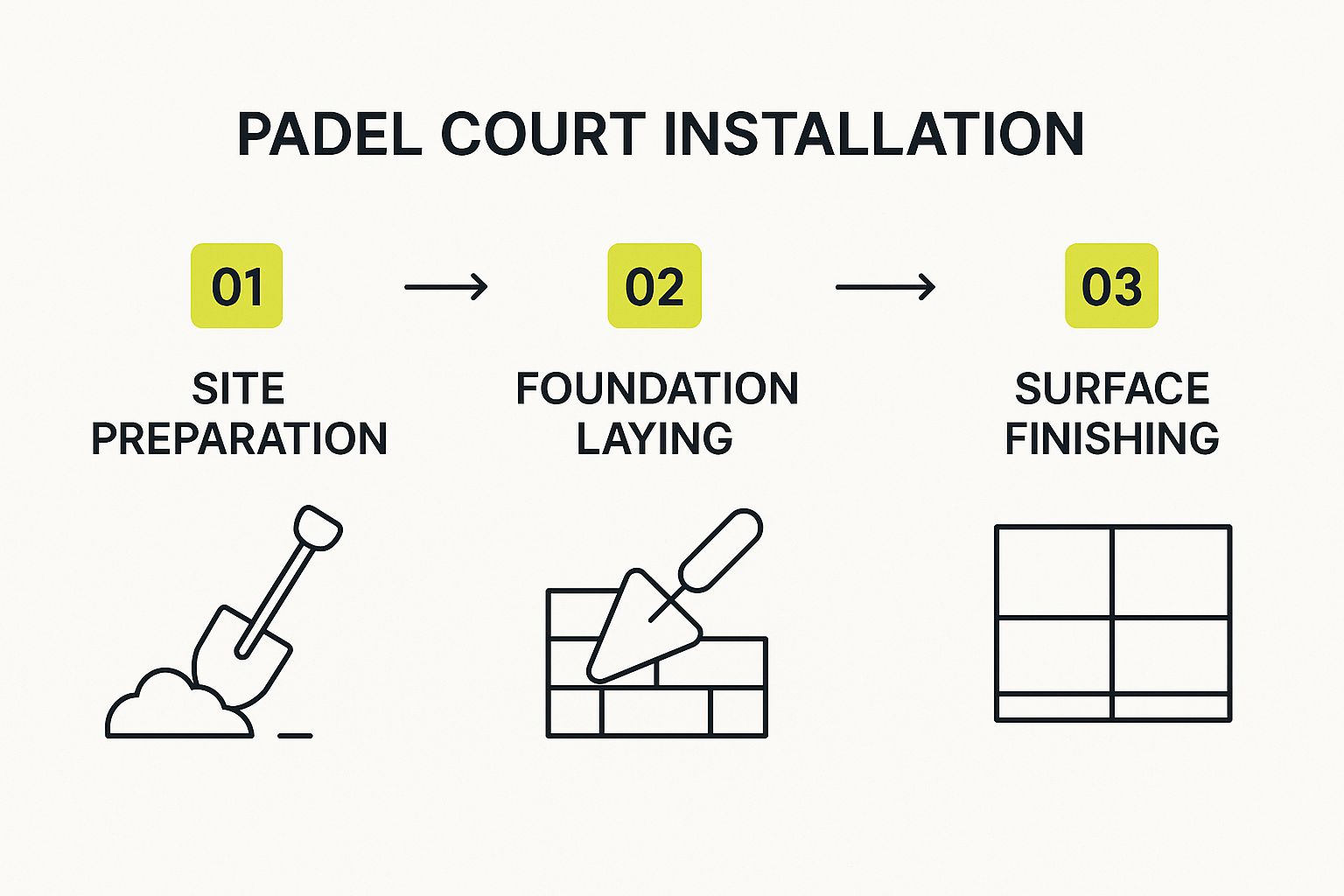
It's a great visual for how a successful project flows from solid groundwork all the way to a perfectly finished playing surface.
Stage 3: Surface and Final Touches
The court is now enclosed, but it’s not quite ready for its first match. The final stages are what really transform it from a glass box into a proper playing arena. This is where the artificial turf is laid, the lights are installed, and the net is set up.
Laying the artificial turf is a meticulous job. The turf is rolled out, cut precisely to size, and seamed together. Then, a layer of silica sand is spread evenly across the surface. This sand is vital for a few reasons:
- It acts as a ballast, weighing the turf down and keeping it in place.
- It helps the turf fibers stand upright, making the surface more durable.
- It controls the speed and height of the ball bounce, giving you a consistent game.
Finally, the finishing touches are added. This means installing the net to the correct height and tension and, for an outdoor court, integrating the lighting system. LED lights are the standard these days, giving you bright, even light with lower energy bills. The details of lighting and climate control are especially key, a topic you can dive into with our guide to https://padelrumors.pages.dev/news/indoor-padel-courts/.
By following these steps methodically, you’ll ensure your padel court is built not just for looks, but for top performance, safety, and a long life.
Breaking Down Padel Court Costs and Your Investment
So, you're thinking about building a padel court? Whether you're a budding club owner or a homeowner dreaming of a private court, understanding the money side of things is the first big step. It's easy to see it as just another expense, but that's missing the bigger picture. This is really an investment in a sport that's exploding globally, which means real returns for commercial courts and a whole lot of fun for private ones.
The final price tag isn't a simple, one-size-fits-all number. It's a mix of several key parts, and the total can swing wildly depending on where you are and the materials you pick. A standard club court won't have the same budget as a top-of-the-line panoramic court built for the pros.
Dissecting the Core Expenses
Let's get into the nitty-gritty of where the money goes. The biggest chunk of your budget will be the court kit itself. This is the package deal that usually includes the steel frame, the tempered glass walls, wire mesh, and the artificial turf. For a basic kit, you're looking at a range of $15,000 to $30,000, with panoramic models sitting at the higher end of that scale.
But the kit is just the start of the journey. You've got to account for a few other major costs:
- Groundwork and Foundation: You can't just drop a court anywhere. Preparing the site with a solid concrete base is non-negotiable and can add $8,000 to $15,000 to your costs, depending on your land and local labor prices.
- Shipping and Logistics: Getting that big, heavy kit to your doorstep is another line item. This can run anywhere from $2,000 to $5,000, and sometimes more if it's coming from overseas or to a remote location.
- Professional Installation: Unless you're a construction pro, you'll need a specialized crew to put it all together. Expect to pay between $5,000 and $10,000 for their expertise.
Building a padel court is a construction project, plain and simple. And like any project, unexpected costs can pop up. Smart Construction Cost Management Strategies are crucial to keep your court build on time and on budget.
To give you a clearer picture, here’s a rough breakdown of what you can expect to spend on a single outdoor court.
Estimated Cost Breakdown for Padel Court Construction
| Cost Component | Estimated Price Range (USD) | Key Considerations |
|---|---|---|
| Court Kit | $15,000 – $30,000 | Panoramic vs. standard model, glass thickness, turf quality. |
| Groundwork & Foundation | $8,000 – $15,000 | Site accessibility, soil conditions, local concrete costs. |
| Installation Labor | $5,000 – $10,000 | Experience of the installation crew, local labor rates. |
| Shipping | $2,000 – $5,000 | Distance from manufacturer, fuel costs, international vs. domestic. |
| LED Lighting | $3,000 – $7,000 | Number of poles (4 or 8), lumen output, brand quality. |
| Roofing/Canopy | $10,000+ | Highly variable based on materials, design, and size. |
| Total Estimated Cost | $33,000 – $77,000+ | A basic court will be at the low end; a premium, covered court at the high end. |
Keep in mind these are estimates. Your final costs will depend heavily on your specific choices and location.
Valuable Add-Ons That Impact Your Budget
Once you have the basics covered, you can think about upgrades. These extras will bump up the initial cost, but they can seriously enhance the playing experience and make your facility the go-to spot for players.
The most popular add-on is LED lighting. It's a must-have for any club that wants to keep the courts busy after sunset, bringing in more revenue. A good lighting system will set you back $3,000 to $7,000 per court. Another game-changer is a roof or canopy. It’s a hefty investment, for sure, but making your courts playable year-round in rainy or scorching hot climates is a massive advantage.
This investment is happening inside a market that is absolutely on fire. In 2022, Europe had over 31,400 of the 40,000 courts worldwide. Experts predict that courts in Continental Europe will grow by 26% every year, hitting nearly 67,000 courts by 2025. That's some serious, sustained demand. If you want to dive deeper, you can learn about padel's growth statistics and see just how big this is getting.
When you look at it this way, the cost becomes a strategic decision. A bare-bones outdoor court might land you around $30,000 all-in. But a premium indoor court with all the bells and whistles could easily top $60,000. By understanding what each piece of the puzzle costs, you can build a court that fits your vision and your wallet, making sure it’s a venture that pays off for years to come.
Protecting Your Asset with Essential Maintenance
So, you've invested in a padel court. That's a huge step! But now comes the important part: keeping it in top shape. Think of your court like a high-performance car; it needs regular tune-ups to perform its best. Consistent care isn’t just a chore—it’s the single best way to protect your investment and ensure it’s safe for every match.
This goes way beyond just making it look nice. A neglected court can quickly become a hazard. If the turf gets compacted, it can be slippery, and dirty glass walls make it tough to track the ball. A well-maintained court, on the other hand, will be a premium feature for years to come.
The Core Maintenance Checklist
The good news? Keeping your padel court in prime condition doesn't require a massive amount of time. It just takes consistency. The two most critical areas to focus on are the artificial turf and the glass panels, as they have the biggest impact on gameplay and safety.
Brushing the artificial turf is easily the most important task on your list. A simple sweep with the right brush redistributes the silica sand, which does a few vital things:
- It keeps the turf fibers propped up, which stops them from wearing out too quickly.
- It ensures the ball bounces predictably no matter where it lands.
- It gives players the perfect amount of grip and slide for those quick, explosive movements.
At the same time, keeping the glass panels clean is a must. During a fast-paced rally, you need perfect visibility. Regular cleaning gets rid of the dust, smudges, and handprints that can get in the way of a player's view of the ball.
A proactive maintenance plan is the difference between a court that lasts a decade and one that needs expensive repairs in just a few years. It's the most effective way to protect your initial investment and guarantee a safe playing environment.
Your Simple Upkeep Schedule
To make things easy, here’s a straightforward schedule you can follow. Sticking to this routine will help you avoid common problems like compacted sand, algae growth, or loose fixtures, making sure your court stays ready for action.
Weekly Tasks:
- Brush the Turf: Grab a drag brush and go over the entire surface. This helps spread the sand out nice and evenly.
- Inspect the Net: Check that the net tension is right—it should be 88cm high at the center. Give it a quick look for any tears or fraying.
- Clear Debris: Do a quick sweep for any leaves, twigs, or other bits of trash on the court and in the drainage areas.
Monthly Tasks:
- Clean the Glass: Wipe down all the glass panels with a soft cloth and a good glass cleaner.
- Check Fixtures: Take a minute to check the bolts and screws on the main structure and gates to make sure everything is still tight.
- Top Up Sand: If you start noticing some spots where the bounce feels off or the sand looks low, it might be time to add a bit more silica sand.
Frequently Asked Questions About Padel Courts
When you start looking into the world of padel courts, a whole host of practical questions pop up. Whether you're a club owner thinking about an installation or just a curious player, getting straight answers is crucial. Let's tackle some of the most common queries so you can feel confident about your next steps.
How Much Space Do I Actually Need?
This is probably the number one question we get, and the answer involves more than just the court's playing area. A standard padel court is 10 meters wide by 20 meters long. But that’s just the space inside the glass.
You have to factor in the out-of-play area surrounding the structure for safety and access. We recommend a minimum footprint of 11m x 21m for a comfortable, safe installation. For a club setting or a tournament-level court where people will be walking between courts, you’ll want a bit more breathing room—at least 12m x 22m is a much better bet.
Don’t forget to look up! Vertical space is just as important, especially for indoor courts. A ceiling height of 7 meters is the absolute minimum to allow for lobs without hitting the roof. For a truly premium playing experience, though, 8 meters or more is the ideal.
Can You Play Padel Singles?
While padel is famous for being a doubles game, you can absolutely play singles—and it's getting more popular. The catch is that it’s usually played on a specially designed singles court, not the standard version.
A singles padel court is narrower, measuring 6 meters wide by 20 meters long. Trying to play one-on-one on a full-sized doubles court is an incredible workout, but it completely changes the game. Covering all that ground is extremely difficult and shifts the strategy away from what makes padel, padel. If singles is your main interest, a purpose-built court is the way to go.
What Is the Difference Between Padel and Pickleball Courts?
It's easy to lump these two fast-growing racket sports together, but their courts are fundamentally different. A pickleball court is much smaller, at 6.7m x 13.4m, and features a "kitchen" or non-volley zone right behind the net. It has no walls and looks more like a mini tennis court.
A padel court, on the other hand, is significantly larger and is completely defined by its glass and mesh walls. These walls aren't just boundaries; they are an active part of the game. The skills are totally distinct—padel is all about using rebounds and playing a three-dimensional game, while pickleball strategy centers on dinks and aggressive net play. If you're looking for a new spot to play, our guide to finding padel courts near you can help you locate facilities in your area.
At Padel Rumors, we're your ultimate resource for everything padel, from in-depth player news and tournament coverage to expert advice on the best gear. Explore our site to master the game and stay on top of the latest trends. Visit us at https://padelrumors.pages.dev to learn more.


